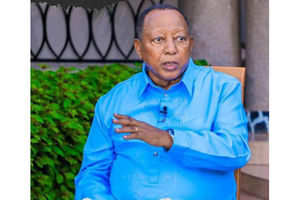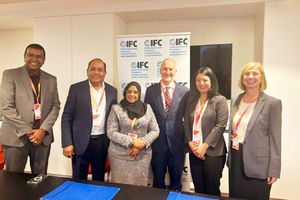Prime
Shekilango: A hero lost in service to Tanzania

The late Hussein Shekilango
What you need to know:
- It was on Sunday, May 11, 1980, when Tanzania lost its minister, Shekilango, in a plane crash in Arusha.
By William Shayo
Dar es Salaam. It has been 44 years since the death of Hussein Shekilango, after whom the famous Shekilango road in Sinza, Dar es Salaam, was named in his honour.
It was on Sunday, May 11, 1980, when Tanzania lost its minister, Shekilango, in a plane crash in Arusha.
Shekilango was the Managing Director of the National Milling Corporation (NMC) before being elected as a Member of Parliament for Korogwe Town (1975 – 1980).
On Sunday, November 9, 1975, immediately after that year's general election, President Julius Nyerere announced a new Cabinet with two new ministries, namely the Ministry of Justice and the Ministry of Civil Service Planning.
He also restructured the old ministries, resulting in the creation of the Ministry of Finance and Planning, the Ministry of Water, Electricity and Minerals, the Ministry of Industry, and the Ministry of Trade.
Among those appointed to the cabinet was Shekilango, who was appointed Minister in the Office of the Prime Minister.
The cabinet included Vice President Aboud Jumbe, Rashidi Kawawa (Prime Minister and Vice President), Amir Jamal (Finance and Planning), Ibrahim Kaduma (Foreign Affairs), Ali Hassan Mwinyi (Home Affairs), Edward Sokoine (Defense), Julie Manning (Justice), and John Malecela (Agriculture).
Others included Cleopa Msuya (Industry), Alphonse Rulegura (Trade), Wilbert Chagula (Water, Electricity and Minerals), Alfred Tandau (Communications), Nicolas Kuhanga (Civil Service Planning), Isael (Israel) Elinawinga (Education), Leader Stirling (Health), and Mrisho Sarakikya (Culture and Youth).
Others were Daudi Mwakawago (Information and Broadcasting), Solomoni Saibul (Natural Resources and Tourism), Thabita Siwale (Land, Housing and Urban Development), Crispin Tungaraza (Labor and Social Welfare), Louis Sazia (Construction), Hasnu Makame (President's Office - Headquarters Establishment), and Peter Siyovelwa (President's Office).
Junior ministers appointed to the cabinet were Isaac Sepetu (Foreign Affairs), Seif Bakari (Defense), Edward Barongo (Agriculture), Chrisant Mzindakaya (Industry), Nazar Nyoni (Education), Mustafa Nyang'anyi (Health), Robert Ng'itu (Prime Minister's Office), and Ali Mchumo (Prime Minister's Office).
On February 13, 1977, President Nyerere made significant changes to the Cabinet, promoting Defense Minister Edward Sokoine to Prime Minister, replacing Rashidi Kawawa.
In these changes, eight new ministers were appointed, and seven were removed from the Cabinet.
Seven ministers changed their positions, but Shekilango remained in his original position.
In 1978, when the Kagera War broke out, the Tanzania People's Defense Forces (JWTZ) ended the rule of dictator Idi Amin and handed over power to Prof Yusufu Lule as the country's interim President.
However, Prof Lule's presidency lasted only 68 days, from April 13 to June 20, 1979. His major mistake was not obeying the National Consultative Council (NCC).
He appointed ministers and deputy ministers without consulting the council.
As such, Lule became the shortest-serving president in Uganda's history.
After Lule was removed from office overnight, once again, Uganda was left without a president.
Three names were proposed—Paulo Muwanga, Edward Rugumayo, and Godfrey Binaisa. Eventually, Binaisa was entrusted with power.
While Binaisa was celebrating his election as President of Uganda, hiding in Nile Mansions Hotel, Radio Uganda announced on Wednesday afternoon, June 20, 1979, that the country's citizens had begun gathering in the streets to protest against his presidency.
By evening, the streets of Kampala were filled with people singing, "We want Lule. We want Lule." Throughout the night, more people poured into the streets. The noise became so loud that Binaisa couldn't sleep.
Tanzanian troops entered Kampala to try to restore order, but some were pelted with stones. Meanwhile, Prof Lule was detained at Entebbe State House, where he was only receiving reports of the demonstrations. This made him continue to claim that he was the legitimate President of Uganda.
Many workers and traders in Kampala went on strike. But Defense Minister Yoweri Museveni went to the Radio Uganda studios and banned the demonstrations. Protesters left the streets, but business came to a standstill.
Binaisa and Tanzanian President Julius Nyerere had to think about how to deal with Lule's problem. Since Lule still claimed to be the President of Uganda, and with Uganda having another president, he should not remain in Uganda. He was summoned by President Nyerere to Dar es Salaam.
Lule travelled to Dar es Salaam accompanied by one of the NCC leaders, Dani Wadada Nabudere. According to the book "UPC and National-Democratic Liberation in Uganda" by Yoga Adhola, Lule was received at Dar es Salaam airport by Tanzania's Defense Minister, Rashid Kawawa, and the Presidential Secretary, Joseph Butiku, and taken to the State House.
The following morning, Nyerere went to see him and talk to him. He told him he had received conflicting reports from Entebbe, some saying Lule had resigned voluntarily and others claiming he was forced. Nyerere asked him to tell him the truth. Lule replied to Nyerere that he did not come to Dar es Salaam to discuss those issues.
Lule's assistant, James Senabulya, according to an article written by Ssemujju Ibrahim Nganda and published in 'The Observer' newspaper on August 10, 2009, Nyerere sent Lule a document and told him, "Sign here to resign from the presidency of Uganda because we now have another president."
Lule refused. But he remained in Dar es Salaam for several days. A few days later, Nyerere, or his representatives, approached Lule again to see if he had changed his mind. Lule refused. But Nyerere visited Lule several times.
At one point, he asked Lule a question: "Do you still think you are the legitimate President of Uganda?" This annoyed Lule. Nabudere told Lule to stop complaining. Lule said his conscience troubled him and that he wanted Uganda to have a referendum.
Nabudere told him that, given the violence in Uganda, a referendum was not possible. He told him that if he made a statement supporting Binaisa, he would have no problem returning to Uganda. Nyerere began to see Lule as obstinate.
Later, Nyerere said that if Lule denied his statement that he was not the President of Uganda, he would not be allowed to leave Dar es Salaam.
Shekilango sent to Uganda
When the Uganda-Tanzania war ended and Uganda's situation became difficult, Hussein Shekilango was sent by President Nyerere to set things right and oversee Uganda's new transitional government, assisted by Ambassador Faraji Kilumanga.
Shekilango was given the special task of coordinating between the Ugandan government and Tanzania after the war and calming the unrest in Uganda.
While in Uganda, Shekilango and Ambassador Kilumanga planned to meet with President Nyerere in Arusha, where he was on a state visit, to give him feedback on the turmoil between President Binaisa and Uganda's Army Commander, Lt Colonel David Oyite Ojok.
On the morning of Thursday, April 24, 1980, Radio Uganda announced that Binaisa had dismissed Ojok and appointed him as Uganda's Ambassador to Algeria. This was the beginning of the end for Binaisa.
Government officials began to be abducted. Binaisa himself was holed up in State House Entebbe, afraid to leave. All his communications were cut off except for a phone he used to call journalists in Kampala to tell them he was still the President of Uganda.
Museveni, Muwanga, and Ojok began working together to oust Binaisa. A Military Commission began the process of removing Binaisa from power. The Commission could only have been stopped by the Tanzania People's Defense Forces.
Amidst all this conflict resolution, Hussein Shekilango was present. But early on Sunday, May 11, 1980, Shekilango led a delegation of Tanzanian government officials from Uganda to Arusha in a small Cessna 402 plane capable of carrying eight passengers.
The crash in Arusha
On that day, the JWTZ plane crashed in the village of Engwiki, Monduli district, Arusha region. It exploded after hitting the Komoloniki hill on its way to Kilimanjaro International Airport (KIA).
Officers from the Monduli Military Academy and villagers from Engwiki spent five hours searching for and collecting the remains of the plane's passengers.
Passengers who died in the crash included Shekilango, Ambassador Faraji Kilumanga, who was Tanzania's Ambassador to Uganda, and Shekilango's chief assistant, Faraji Iddi Msechu; JWTZ soldiers, Corporal Petro Kalegi Magunda, Private Stephen Mlawa, Lieutenant Mally, and Lieutenant Luoga.
The next day, Monday, May 12, 1980, Godfrey Binaisa was removed from his presidency of Uganda, and all presidential activities were supervised by the Military Commission chaired by Paulo Muwanga and his deputy, Yoweri Museveni. The Muwanga and Museveni leadership oversaw the activities for 10 days—from May 12 to May 22, 1980.
From May 22, the Military Commission handed over its powers to the Presidential Commission, which supervised the work from then until December 15, 1980, when the General Election was held in the country and the results were announced.
The General Election was called and held on Wednesday, December 10, 1980, and Milton Obote's Uganda People's Congress (UPC) was declared the winner, and Obote returned to power as President of Uganda for the second time. International observers said the election was neither free nor fair.
While all this was going on, Minister Shekilango was buried in Jitengeni, Mombo, Korogwe, Tanga region. At the time of his death, construction of the Sinza road had just begun. In honour of Shekilango, the Dar es Salaam City Council named the road after him.




